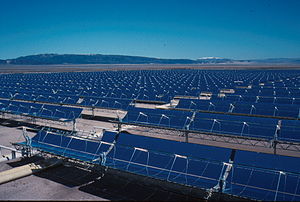Over the past six years, solar energy capacity has more than doubled in 45 of America’s 57 largest cities, according to a new study released by Environment America Research & Policy Center. The report, “Shining Cities 2019: The Top U.S. Cities for Solar Energy,” is the sixth annual edition of the group’s survey of installed solar PV capacity in major U.S. cities. Along with the vast majority of cities that showed marked growth in solar capacity, a select group made even greater strides in going solar between 2013 and 2018, the report finds. One-third of the cities surveyed in all of the report’s editions more than quadrupled their installed solar PV capacity over that period.
 “Cities are rapidly adopting solar energy and driving the renewable energy transition across the country, bringing pollution-free power to our homes, schools and workplaces,” states Bret Fanshaw, Go Solar campaign director with Environment America Research & Policy Center. “We applaud the leadership shown by many cities and invite even more to let the sunshine in.”
“Cities are rapidly adopting solar energy and driving the renewable energy transition across the country, bringing pollution-free power to our homes, schools and workplaces,” states Bret Fanshaw, Go Solar campaign director with Environment America Research & Policy Center. “We applaud the leadership shown by many cities and invite even more to let the sunshine in.”
Beyond the historical analysis, the 2018 report expanded to include 69 major U.S. cities. The newest numbers show that Honolulu ranks No. 1 for solar energy installed per resident. According to Environment America, this performance from Hawaii’s capital reflects strong state and local commitments to tackle climate change: In 2015, the Aloha State committed to using 100% renewable energy by 2045.
“As mayor, I am proud that Honolulu continues to lead the nation with the highest solar PV capacity per capita,” says Honolulu’s mayor, Kirk Caldwell. “O‘ahu residents are making great use of one of our most abundant resources, the beautiful Hawaiian sunshine. As more residents install rooftop solar to power their homes, heat their water and lower their energy costs, our city moves closer to achieving the goal of decarbonizing our economy.” Following Honolulu for solar PV installed per capita are, in order, San Diego; San Jose, Calif.; Burlington, Vt.; Las Vegas; Phoenix; Indianapolis; Riverside, Calif.; Denver; and Albuquerque, N.M.
When it comes to overall solar PV installed, Los Angeles remains the leader for the second year in a row, after ceding the top spot to San Diego two years ago. L.A. has taken this spot in five of the six years of the survey.Following L.A. for overall solar PV installed are, in order, San Diego; Phoenix; Honolulu; San Jose; New York; San Antonio; Indianapolis; Las Vegas; and Denver.
In addition to the overall rankings, regional leaders for solar capacity per capita were Burlington, Vt., in the Northeast; Washington, D.C., in the South Atlantic; San Antonio in the South Central region; Indianapolis in the North Central region; Las Vegas in the Mountain region; and Honolulu in the Pacific region.
“The difference between cities leading on solar energy and those that are lagging is effective public policy at the state and local level,” comments Abigail Bradford, report co-author and policy analyst at Frontier Group. “A dozen cities in our report have made commitments to use 100 percent renewable energy, and many more have programs and policies that encourage residents to install solar panels.”
Focusing on Burlington in particular, the report says the city ranked fourth nationwide for solar energy capacity per capita. It ranked ahead of other Northeastern cities such as Boston and Newark, N.J., and just behind San Jose, Calif., for megawatts of solar energy capacity per capita as of year-end 2018.
“The Queen City can also be known as one of America’s ‘Solar Stars,’” says Emma Searson, Go Solar Campaign advocate with Environment America Research & Policy Center. “Burlington’s use of solar energy sets an example for the rest of the country.” The cities with the most solar PV installed per capita are considered “Solar Stars” — cities with 50 or more watts of solar PV capacity installed per capita. In 2013, only eight of the cities surveyed for the report had enough solar PV per capita to be ranked as “Solar Stars,” but now, 23 cities have earned the title.
Also highlighting D.C., the report points out that the U.S. capital ranked 15th nationwide and first in the South Atlantic for solar energy capacity per capita. D.C. ranked ahead of Jacksonville, Fla., and just behind Los Angeles for megawatts of solar energy capacity per capita. Last year, the city completed an 11.8 MW solar portfolio with WGL Energy that now powers a variety of schools, hospitals, recreation centers and other city facilities, the report says. Of course, the city also recently committed to 100% clean energy by 2032.
Lastly, Environment America highlights Salt Lake City, which ranked 11th nationwide for solar energy capacity per capita, placing it ahead of Los Angeles and just behind Albuquerque, N.M. The city is using solar energy as part of its commitment to achieving 100% renewable electricity by 2032.
“We are thrilled to see Salt Lake City listed among the solar energy leaders in Shining Cities,” says Salt Lake City’s mayor, Jackie Biskupski. “Sustained development of solar resources is an essential pillar of our efforts to address climate change. Powering homes and businesses with clean, renewable energy creates jobs, reduces pollution and offers stable electricity rates. I’m proud to see so many of our community members invest in a clean energy future.”
More on the report can be found here.

